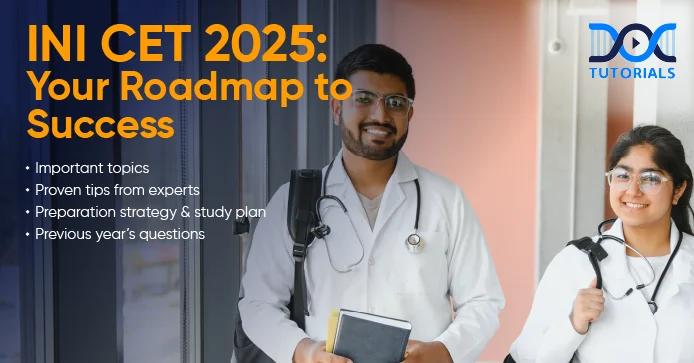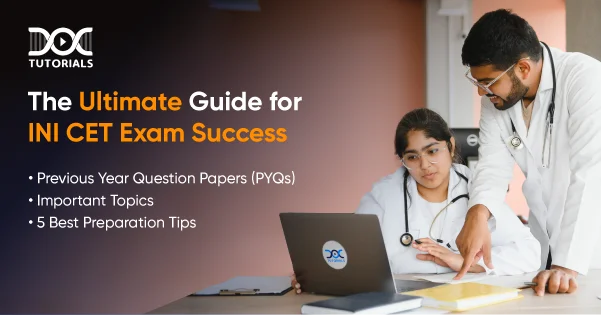Blindness: Causes, Symptoms, Diagnosis, and Treatment

When a person loses all or nearly all of their eyesight, it is called blindness, and it significantly impairs their ability to carry out daily tasks. Blindness may occur suddenly or develop gradually over time, and it can be either partial or total depending on the origin and severity of the loss of vision.
It is an important field of ophthalmology research since vision loss can be caused by trauma, systemic illnesses, or a number of eye disorders. This page provides a summary of blindness’s causes, symptoms, risk factors, and diagnostic techniques.
Additionally, it provides a broad summary of available treatments, enabling aspiring medical students to comprehend the clinical characteristics of this illness with clarity before taking the NEET PG exam. To have a thorough understanding of blindness, continue reading.
What is Blindness?
Blindness is a total or near-total loss of vision that is non-correctable with glasses, contact lenses, or routine surgery. Blindness has been defined by the World Health Organisation (WHO) as a visual acuity worse than 3/60 in the better eye, even with the best possible correction.
Blindness can be of various types, such as:
- Partial Blindness
Impaired sight in one or both eyes, with some vision, but with day-to-day activities still hindered.
- Total Blindness
Total loss of light perception, where independent movement is severely difficult without assistance or supporting tools.
- Congenital Blindness
Present at birth due to inherited conditions, developmental anomalies, or prenatal infections or similar causes.
- Acquired Blindness
Arises later in life secondary to disease, trauma, or a progressive eye condition due to age.
Understanding the exact type is crucial in enabling precise diagnosis, proper prognosis, and choice of effective treatment or rehabilitation plan.
What are the Causes of Blindness?
The causes of blindness vary among populations, but some cases show universal occurrence. Recognising these is essential for both prevention and treatment:
- Cataract
Clouding or opacification of the normal lens of the eye, usually due to age, but in some cases, results from trauma or metabolic disease. It is still the most common cause of preventable blindness in the world.
- Glaucoma
It happens due to gradual damage to the optic nerve, commonly in association with elevated pressure within the eye, and results in permanent loss of vision if left untreated.
- Diabetic Retinopathy
Damage to retinal blood vessels following long-standing, uncontrolled diabetes, resulting in haemorrhage, leakage of fluid, or detachment of the retina.
- Age-related Macular Degeneration (AMD)
A gradual breakdown of the macula, which is responsible for central vision required for reading and face recognition, hence, hampering the ability to see.
- Corneal Opacities
Scarring or clouding of the cornea secondary to infection, trauma, or vitamin A deficiency.
- Eye Injury
Penetrating or blunt trauma that results in damage to eye tissues or the optic nerve.
- Retinal Detachment
Detachment of the retina from its underlying supporting tissue usually necessitates immediate surgery.
- Infectious Causes
Infections like onchocerciasis (river blindness) or trachoma can lead to enormous vision loss in certain regions.
While some of the causes are irreversible, the majority can be prevented or treated by early access to medical treatment, emphasising the importance of public health interventions and early diagnosis.
What are the Risk Factors of Blindness?
Some factors enhance the risk of becoming blind, and their recognition becomes essential to facilitate the reduction of risk:
- Age
Age-related conditions, such as cataract, glaucoma, and AMD, develop more commonly in individuals above 50 years of age.
- Hereditary Factor
A history of glaucoma, retinitis pigmentosa, or macular degeneration in the family elevates an individual’s risk of blindness.
- Systemic Disorders
Disorders such as diabetes mellitus, hypertension, and autoimmune disorders can cause injury to the structures of the eye over time.
- Lifestyle Variables
Smoking, undernutrition (low-vitamin-A diet), and long-term exposure to injurious UV (ultraviolet) radiation are the other risk factors leading to eye damage.
- Occupational Hazard
Occupations with the use of dangerous machinery, chemicals, or high-impact exposures put individuals at a higher risk for eye damage.
Identification of these risk factors is a crucial part of a patient’s education, screening, and application of preventive care measures in medical students.
What are the Symptoms of Blindness?
Symptoms of blindness are variable with the cause, duration of the disease, and extent of loss of vision. Prompt recognition of these symptoms can be the key to preserving or losing one’s vision. The following are the common signs warranting medical assessment:
- Gradual or Sudden Loss of Vision
This may develop in one or both eyes, and the speed of onset often gives a clue to the underlying condition.
- Cloudy or Blurred Vision
Normal in cataract, corneal disease, or important uncorrected refractive error, and may develop suddenly or over a long time.
- Loss of Side (Peripheral) Vision
Typically develops in glaucoma, which is frequently not recognised until well advanced in the condition and necessitates regular screening.
- Blindness in The Dark (Nyctalopia)
Dimness of vision in darkness, usually associated with vitamin A deficiency or hereditary retinal disease like retinitis pigmentosa.
- Increased Sensitivity to Light
This is also known as photophobia and can be dazzling in corneal disease or inflammatory eye disease such as uveitis.
- Flashing Lights, Floaters, or Shadow vision
These eye disturbances can presage retinal detachment or vitreous haemorrhage and necessitate urgent assessment.
Identification of such prodromal signs and early ophthalmic examination can initiate therapy before any loss of sight becomes irreversible.
What is the Diagnosis of Blindness?
Diagnosis of blindness is a thorough and systematic clinical process to determine its cause, severity, and reversibility. The major steps to diagnosis are:
- Visual Acuity Examination
Examines the sharpness and clarity of vision, typically with a Snellen chart, and is utilised to establish a baseline impairment level.
- Refraction Testing
Assesses whether loss of vision can be restored with prescription glasses, separating refractive from pathologic aetiology.
- Ophthalmoscopy (Fundoscopy)
Allows direct visualisation of the retina, optic disc, and retinal vessels to identify signs of disease or structural damage.
- Tonometry
Provides an accurate measurement of intraocular pressure, particularly important in early detection of glaucoma and follow-up.
- Visual Field Testing
Tests the peripheral visual field extent, helpful in glaucoma, optic nerve illness, and certain neurological disorders.
- Ocular Imaging
Advanced methods like optical coherence tomography (OCT) and fundus photography take high-quality pictures, so that thorough structural assessment can be performed.
All of these extensive testing enables clinicians to determine the exact cause of the loss of vision and choose the best treatment or rehabilitation strategy for the patient.
What are the Treatment Options for Blindness?
Blindness is managed according to cause, stage of disease, and potential for vision improvement. The treatment options include:
- Cataract Removal
Involves the surgical removal of the clouded lens and its replacement with a clear artificial intraocular lens, and is considered a very successful operation in restoring useful vision.
- Treatment of Glaucoma
Uses pressure-reducing eye drops, laser, or surgery to reduce further damage to the optic nerve and slow progression.
- Diabetic Retinopathy Treatment
It can involve laser treatment (photocoagulation), targeted anti-VEGF (anti-vascular endothelial growth factor) injections, or vitrectomy to manage bleeding, shrink swelling in the retina, and salvage vision.
- Corneal Transplant (Keratoplasty)
Replaces defective or cloudy corneal tissue with healthy tissue from a donor, enabling vision to be restored when the cornea is primarily the area of injury.
- Retinal Surgery
Used as an emergency for retinal detachment or macular holes, restoring or maintaining vision where feasible.
- Low Vision Rehabilitation
In cases of irreversible blindness, individually tailored training and adaptive equipment like magnifiers, Braille publications, and screen readers maximise autonomy and quality of life.
Prevention of blindness remains crucial, based on periodic eye examinations, safety glasses, management of systemic disease, and proper diet, especially that with adequate vitamin A for children to avert avoidable visual impairment.
FAQs about Blindness
1. What is the most common cause of blindness globally?
Cataract remains the leading cause, particularly in low- and middle-income countries.
2. Is it possible to avoid blindness?
Yes, in nearly all instances, prompt detection, routine eye exams, and treatment of systemic illnesses will avert blindness.
3. What are the earliest warning signs of glaucoma-induced blindness?
Slow peripheral loss of vision, which is often not noted until late in the condition.
4. Why are complications of diabetes responsible for blindness?
High blood sugar damages the retinal blood vessels, leading to diabetic retinopathy.
5. Is congenital blindness curable?
That depends on the cause; some can be cured with therapy or surgery, while some are not curable.
Conclusion
Blindness is a complex condition with extensive ramifications for patients and communities. There are some irreversible causes, yet most are avoidable or treatable if intervened upon early and appropriately. For medical students, learning about this topic not only aids in the preparation for NEET PG but also forms the roots of successful patient care in clinical practice.
DocTutorials provides systematic ophthalmology modules that make complicated notions such as blindness easier to understand, pairing clinical applicability with exam-oriented study plans, enabling students to consolidate both their knowledge and diagnostic abilities.
Join DocTutorials and explore our NEET PG course to excel in your medical career.
Latest Blogs
-

INI CET Exam 2025: Your Roadmap to Success – Key Topics, Strategies, and Lessons from Last Year’s Papers
The INI CET exam is more than just a test; it’s a significant milestone for many medical students aiming to…
-

INI CET Exam Success: Previous Year Question Papers & Ultimate Guide – INI CET PYQ
One can feel overwhelmed while preparing for the INI CET (Institute of National Importance Combined Entrance Test). A vast syllabus,…
-

INI CET Exam Pattern 2024: A Complete Guide with Subject-Wise Weightage
The Institute of National Importance Combined Entrance Test (INI CET) is your key to entering some of the most prestigious…




